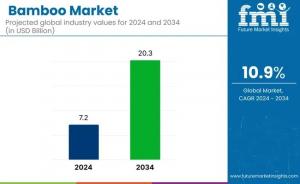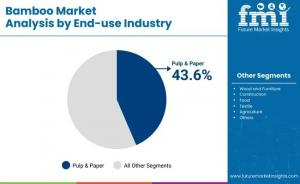Global and European Bamboo Market Outlook 2024 to 2034
The bamboo market will grow from USD 7.2 billion in 2024 to USD 20.3 billion by 2034, expanding at a CAGR of 10.9%.
NEWARK, DE, UNITED STATES, November 13, 2025 /EINPresswire.com/ -- According to the latest report by Future Market Insights (FMI), the global bamboo market is poised for exponential expansion, projected to rise from USD 7.2 billion in 2024 to USD 20.3 billion by 2034, reflecting a CAGR of 10.9%. With strong policy support for eco-friendly materials and accelerating sustainability initiatives across Asia-Pacific, Europe, the United States, and Saudi Arabia, bamboo is rapidly evolving from a traditional raw material to a modern green industry cornerstone.
FMI’s analysis shows that bamboo’s pulp and paper segment will command nearly 43.6% of total market value by 2034, supported by surging demand for sustainable packaging and biodegradable alternatives to wood-based pulp. From luxury furniture in Europe to eco-fashion in the USA and construction innovation in Asia and the Middle East, the versatility and renewability of bamboo are redefining global material markets.
Subscribe for Year-Round Insights → Stay ahead with quarterly and annual data updates: https://www.futuremarketinsights.com/reports/sample/rep-gb-347
Sustainability Transforms the Bamboo Economy
Bamboo’s ability to regenerate without replanting and mature within 3–5 years—compared to traditional timber’s 20–30 years—makes it one of the fastest renewable materials available. According to the UN Food and Agriculture Organization (FAO), bamboo covers more than 35 million hectares globally, concentrated across Africa, Asia, and the Americas.
“Bamboo is transitioning from being a rural resource to a global sustainability symbol,” said an FMI analyst. “Its strength-to-weight ratio, carbon sequestration potential, and versatility make it an indispensable component of green infrastructure and consumer goods manufacturing.”
Driven by both environmental awareness and material innovation, bamboo is now used in bioplastics, textiles, furniture, home décor, paper, and construction industries seeking alternatives that meet net-zero goals and circular economy standards.
Asia-Pacific Leads Global Bamboo Production and Consumption
The Asia-Pacific (APAC) region continues to dominate the global bamboo market due to abundant natural resources, expanding industrial capacity, and strong policy support.
- India is projected to grow at a CAGR of 11.7% (2024–2034), supported by government programs promoting sustainable cultivation and industrial use. Bamboo plays a critical role in rural livelihoods and is increasingly used in affordable housing, furniture, and paper production.
- China, home to over 800 bamboo species, is expected to reach a market value of USD 9.8 billion by 2034, expanding at 11.4% CAGR. With its vast bamboo forests and advanced processing technologies, China remains the epicenter of innovation and exports.
- Indonesia and Vietnam are strengthening bamboo value chains through public-private investments and eco-industrial policies to promote green development.
Collectively, APAC nations account for more than two-thirds of global bamboo output, driving exports to North America, Europe, and the Middle East.
Europe: Design-Led Adoption of Sustainable Bamboo Products
In Europe, bamboo is becoming a defining feature of the sustainable design movement. Demand is concentrated in Germany, the Netherlands, France, and the Nordic countries, where consumers prioritize eco-conscious furniture, flooring, and textiles.
European per-capita consumption of bamboo products remains moderate but is rising rapidly, supported by circular economy directives, bans on single-use plastics, and expanding green procurement programs. High-end European furniture and home décor brands are integrating bamboo into modern minimalist aesthetics, positioning it as both luxurious and sustainable.
FMI notes that European construction firms are also exploring bamboo composites for structural reinforcement, bridges, and temporary frameworks, aligning with EU sustainability goals and green architecture trends.
United States: Green Consumerism and Innovation Drive Demand
In the United States, the bamboo market is projected to expand at a CAGR of 10.2% through 2034, fueled by rising consumer preference for sustainable products and innovations in bamboo processing technologies.
American manufacturers and retailers are embracing bamboo for flooring, furniture, and reusable consumer goods, while the textile industry is developing soft, breathable, and antibacterial fabrics made from bamboo fibers. These materials are increasingly used in athleisure, bedding, and eco-fashion, catering to environmentally aware consumers.
FMI highlights that the growing adoption of bioplastics and bamboo composites in the U.S. construction and packaging sectors reflects the country’s shift toward low-carbon manufacturing and green material substitution.
Saudi Arabia and the Middle East: Building the Green Infrastructure Frontier
While the bamboo industry has traditionally been concentrated in Asia and the Americas, Saudi Arabia and the broader Middle East are emerging as new growth frontiers.
Driven by Vision 2030, Saudi Arabia is integrating bamboo into eco-friendly construction, landscaping, and furniture as part of its urban sustainability initiatives. The region’s infrastructure diversification and increasing focus on environmental design have opened opportunities for bamboo imports, processing partnerships, and localized product development.
Bamboo’s natural durability and high tensile strength—comparable to steel—make it particularly suitable for modular construction, scaffolding, and temporary housing in large-scale development projects across the GCC.
Acquire the complete report to access detailed projections, country-level insights, company share assessments, and technology outlooks! Buy Full Report: https://www.futuremarketinsights.com/checkout/347
Pulp & Paper Segment Retains Market Leadership
By sector, pulp and paper remain the largest and fastest-growing segment, capturing nearly 43.6% of total market value. Bamboo fiber’s superior optical properties, whiteness retention, and durability make it ideal for publishing, packaging, and stationery industries.
FMI’s research indicates that bamboo-based pulp not only reduces pressure on forest resources but also offers a lower carbon footprint compared to hardwood alternatives. Construction, the second-largest segment, is expected to reach 20.6% of total market value by 2025, as developers adopt bamboo for bridges, scaffolding, and housing to meet rising green building standards.
Technological Advances Propel Market Expansion
Modern processing technologies are transforming bamboo’s industrial profile. Bamboo-based composites, combining natural fibers with resins, are delivering lightweight yet high-strength panels for construction and furniture applications.
Advancements in bioplastic production are allowing bamboo cellulose to be converted into fully compostable materials, reducing dependence on petroleum-based plastics. The textile sector is also benefiting from innovation—bamboo fabrics are naturally antibacterial, breathable, and biodegradable, making them increasingly popular among global fashion brands.
These technological breakthroughs are bridging the gap between traditional materials and next-generation sustainable solutions, widening the scope for bamboo in global markets.
Challenges and Competitive Landscape
Despite its potential, the bamboo industry faces challenges such as supply chain fragmentation, standardization issues, and competition from alternative sustainable materials like engineered wood and recycled plastics.
However, FMI emphasizes that consistent quality control, value-added processing, and international certifications can enhance competitiveness. Global manufacturers are expanding into emerging regions—particularly South Asia, Latin America, and the Middle East—to capitalize on abundant resources and rising eco-conscious consumer demand.
Exploring Insights Across Emerging Global Markets:
Ethylene Amines Market: https://www.futuremarketinsights.com/reports/ethylene-amines-market
Ethylene Carbonate Market: https://www.futuremarketinsights.com/reports/ethylene-carbonate-market
Paraffins Market: https://www.futuremarketinsights.com/reports/paraffins-market
Ammonium Carbonate Market: https://www.futuremarketinsights.com/reports/ammonium-carbonate-market
About Future Market Insights (FMI)
Future Market Insights, Inc. (FMI) is an ESOMAR-certified, ISO 9001:2015 market research and consulting organization, trusted by Fortune 500 clients and global enterprises. With operations in the U.S., UK, India, and Dubai, FMI provides data-backed insights and strategic intelligence across 30+ industries and 1200 markets worldwide.
Why Choose FMI: Empowering Decisions that Drive Real-World Outcomes: https://www.futuremarketinsights.com/why-fmi
Sudip Saha
Future Market Insights Inc.
+1 347-918-3531
email us here
Legal Disclaimer:
EIN Presswire provides this news content "as is" without warranty of any kind. We do not accept any responsibility or liability for the accuracy, content, images, videos, licenses, completeness, legality, or reliability of the information contained in this article. If you have any complaints or copyright issues related to this article, kindly contact the author above.


